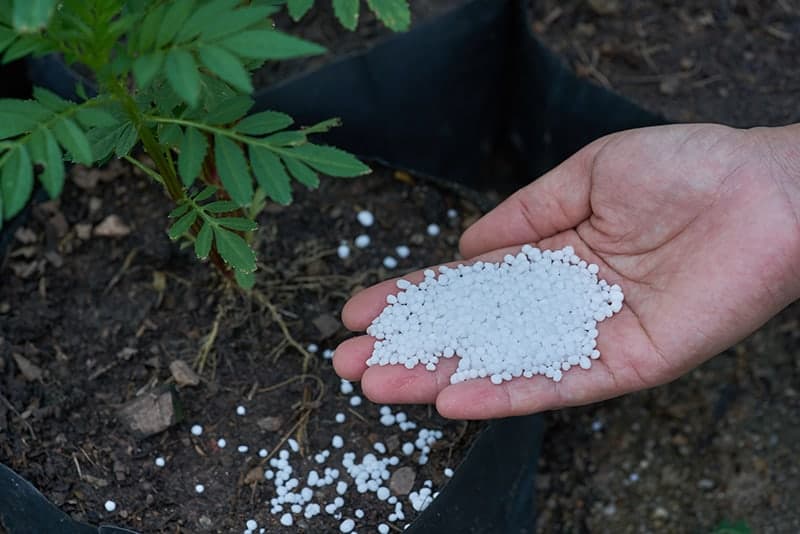Providing plants with a healthy balance of nutrients is essential for good growth. The right balance of nutrients will also help the plant survive disease; get more flowers and better fruits.
But what nutrients does your plant need and are they all the same? Calcium nitrate fertilizer is one of the plant nutrients that, as you may have heard, are particularly useful for crops such as peppers, tomatoes, and apples. But what is calcium nitrate fertilizer? How can it be useful for your plants when you need it, and how do you use it? Read on to find out.
What is Calcium Nitrate Fertilizer?
Calcium nitrate fertilizer is a synthetic compound in the form of salt. It is often used in fertilizer solutions or as a straight fertilizer for household plants, horticultural crops, and vegetables. Calcium nitrate is the only source of water-soluble calcium and is therefore often used in liquid fertilizers or as a foliar spray for direct application on plant leaves.
Why is Calcium Important for Plants?
Calcium is important for the structural support of cell walls.
Absorption of calcium in the plant is a passive process. It is absorbed by the soil together with water. For this reason, the absorption of calcium is directly related to the transpiration rate of plants. Anything that slows down this process, such as high humidity, low temperatures, or high concentrations of other nutrients, leads to a calcium deficiency.
When a plant lacks calcium, the latter forms of growth are often distorted due to the inadequate formation of cell walls. This can be seen in later growth forms such as root tips, shoots, or young leaves. The result can often be described as leaf edge necrosis or leaf burns.
Not all fertilizers contain calcium. It is therefore important to check the fertilizer label to ensure that it contains additional nutrients. If it is not contained in the fertilizer itself, you should supplement it with calcium.
Most of the calcium in the fertilizer is in the form of calcium nitrate. Calcium nitrate is alkaline, so it can increase the pH value of the soil in which the fertilizer is used. Remember to take this into account when adding calcium nitrate, as some plants do in acidic environments.
Symptoms of Calcium Deficiency in Plants
If your plants lack calcium, they show some of the following symptoms. Check them.
Necrosis
Necrosis only means the death of a part of the plant. It usually starts with the darkening of the new leaves, starting at the tips and working from the inside. Finally, the necrotic leaves fall off.
Calcium is a solid nutrient, which means that the plant cannot easily transfer calcium between its tissues. Therefore, new leaves are mainly affected by calcium deficiency. The plant does not easily tolerate calcium from the old rotted leaves to the younger ones, so the leaves turn brown.
Slow Growth
In the absence of calcium, plant roots will be underdeveloped, preventing the absorption of nutrients and water from the soil.
The new leaves can also be small or irregular, so the plant absorbs less sunlight for energy production.
The combination of these factors results in slower plant growth.
Poor Production
A plant that does not contain calcium can also reduce its flowers, resulting in less fruit at harvest. The fruit that appears may be small, irregular, or diseased.
Flower rot at the end of the fruit affects tomatoes and peppers, brown or black spots appear at the bottom of the fruit.
How to Add Calcium to Garden Soil
If you decide that your soil is calcium deficient, you will want to supplement it with natural or chemical additives. It is best to add calcium to your soil in early spring before you plant anything. Here are some ways to do that.
Gypsum
The calcium gypsum or sulfate, dehydrated, comes in the form of powder or granules that can be added and mixed with the soil. The addition of gypsum has little effect on the pH of the soil, so if you are already in the right pH range there is no need to worry about adding it.
Lime
Lime or calcium carbonate is in powder form, which is mixed with the soil in spring. The addition of lime slightly increases the pH of the soil, so bear this in mind if it is slightly elevated. Lime can be found on the Internet or in any garden center.
Bone meal
Bone meal is produced from bones and slaughterhouse waste. It comes in the form of fine powder or coarse granules and is mixed with the soil in spring. Bone meal provides not only calcium but also phosphorus to the soil. Bone meal is available in many garden centers.
Compost
Each spring you can make a mixture of compost and add it to the soil of your garden. Grass cuttings, leaves, banana peel, coffee grounds and other food waste (not meat!) can enter the compost.
Fertilizer
You can also buy fertilizer on the shelves of the garden center. Many fertilizers contain calcium as an addition to the soil. But remember to avoid excess potassium or magnesium, which can block the plant’s calcium absorption.
You can also use a liquid solution containing calcium chloride or calcium nitrate to spray the leaves. This is called foliar fertilization and is a way to save your plants if you have not added calcium before planting in spring.
Conclusion
Calcium nitrate fertilizer is a universal fertilizer that can be used both for plant nutrition and for the treatment or prevention of disease, especially in fruit crops. It contains both calcium and nitrogen and can, therefore, be used to treat plants that lack one of these two nutrients. It is a commercial ingredient or a balanced commercial fertilizer, but can also be easily mixed at home for specific purposes, to be used as an additional root spray or to improve the soil.




